Stepping into Sound with Oscar Nominated Mildred Iatrou Morgan
by Athena Efter
La La Land, the Hollywood “It” movie that won five Oscars for best director, best cinematography, best actress, best original music score, and best production design, can also add a Greek-American woman to its list of Oscar nominees. Mildred Iatrou Morgan, a New York native, was nominated for her outstanding work as a sound editor on Hollywood’s Oscar-winning movie hit this year. That’s a big honor and big accomplishment for one of few women, and a Greek-American woman, who lend their talent to a primarily male dominated industry when it comes to the art of sound design. In NEO’s interview with Mildred, she shares her passion, her thoughts and her experiences on her craft -to bring cadence to the value of sound editing, and what is, like screenwriting, an often underestimated aspect of filmmaking.

Sound Engineer and Oscar Nominated Mildred Iatrou Morgan with colleague Ai-Ling Lee
How did you get into sound editing? Was the art of film sound something that intrigued you from the start?
I got into sound editing by accident but the art of film sound intrigued me from the start too. When I was a film student, my senior thesis film was about my family and I incorporated the silent home movies my parents filmed throughout my childhood into that film. I spent months on elaborate sound editing, adding sound effects and dialogue to the silent images, way more time than on editing the film itself. I recorded and edited in footsteps, zippers, kisses, to match the footage. I actually thought I’d invented the process which I later found was called Foley. My student film had many more tracks than the other students. My school, City College of New York, had an arrangement with the great mixing studio, Sound One (which no longer exists) and I was lucky to get a professional sound mix. It never occurred to me at the time that sound editing was something I could do for a living. I thought it was part of picture editing.
After film school I tried getting work as an assistant editor thinking I would eventually become a picture editor. Over the years I was offered jobs as a sound editor and found I still loved the process so I decided to focus on sound editing instead, specifically dialogue and ADR. The more I edited sound, the more I loved it.
What is the biggest misconception people have about what a sound editor does? Tell us a bit about what sound editors do.
Most people have no idea how much sound work is done on a film. They think the sound they hear in the theater is the sound that was recorded on set during filming. Yes, that production dialogue is part of the sound track but they are also hearing sound effects, backgrounds, Foley footsteps and prop handling, crowds, wallas, and ADR (looping). Also, the production sound needs to be edited and worked on to remove unwanted noise. All the work we do as sound editors creates a soundscape which helps build the world of the film. We help to tell the story, create moods, and describe the characters, sometimes revealing their inner life. Many people don’t realize how important sound is, even film professionals.
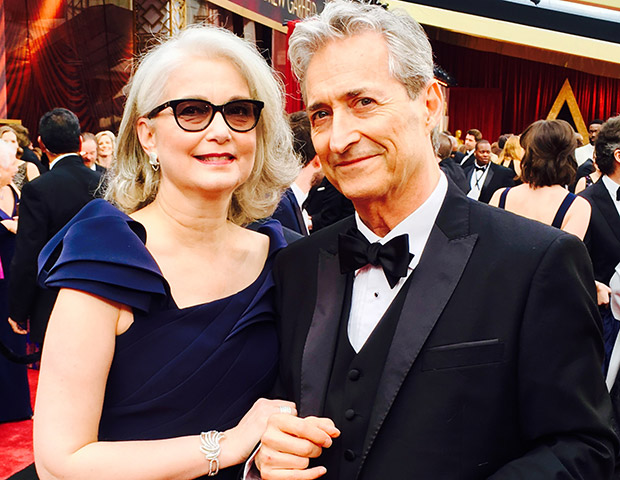
Mildred with husband Ronald Morgan on the red carpet
You’ve had such a long and diverse career of films that you’ve worked on from dramas such as “Wild” and “Hitchcock” to comedies such as “Monte Carlo” to big-scale films such as last two “Planet Of the Apes” films. Do you have a personal favorite genre to work on or does each present its own challenges?
There is something fun and interesting with every film. On big-scale films it’s fun to be part of a big crew, working together to bring the Apes to life, for example. We start by working with scenes where the actors are wearing motion capture clothing and then as we progress the visual effects become more finished and they look like real apes. But I prefer working on the smaller scale films where there is more time spent working intimately with the directors. My two recent favorites are La La Land, where Damien Chazelle was involved with many of the sound decisions so there’s a lot of give and take. He’ll make suggestions on how a scene should sound, then we work on it, play if for him and he gives us notes. We go back and forth like that. It was a similar experience working with Jean-Marc Vallée on Wild, another of my favorites.
How long is the typical process of sound editing? How large is a typical team of editors on a particular project? At what stage do you get involved in a project?
We usually get involved just before the director shows his “director’s cut” to the studio which is 10 weeks after the end of shooting the film. We help smooth out and add to the sound tracks from the picture editor’s Avid. Then a couple of weeks later there is usually an audience preview and we do a lot of sound work for that. We do a Temp Mix so the sound track sounds good for the preview, making sure the dialogue is clear, adding important sound effects and sound design especially to clarify the story and characters. Then from there we add to and fine tune our sound tracks until we get to the final mix where our dialogue, sound effects, etc. are mixed against the finished score. Up until that point we are working with temp music. This whole process lasts anywhere from 3 months to 6 months.
When I first started working in sound, 30 years ago, the sound crews were larger, around 20 people because we were working in film which took a lot longer. When we started to use computers we could work faster so the crews became smaller. On La La Land Ai-Ling Lee and I did most of the editing with a handful of editors helping us for a couple of weeks for the first temp mix. After that it was just the two of us for the most part.

Members of the sound crew attending the Oscars: Ai-Ling Lee, Galen Goodpaster, Teri Dorman, and Mildred Iatrou
What are your experiences with directors? I’ve noticed you’ve worked with some really well-known ones, such as Terence Malik, Cameron Crowe, and Steven Spielberg early in your career. Are some more involved hands on with the sound editor and others less so?
Yes, some directors are more hands on than others. All directors usually have a spotting session where the key members of the sound crew watch the movie with the director while he or she gives notes as to what sounds they want us to add or fix. But then it varies as to how closely they work with us. With Spielberg, for example, we worked on our own for the most part and then at the temp mix and final mix he would give us very specific notes on which sounds should be the most prominent and which should melt away, the idea being to focus on the most important aspects of each scene: what we want the audience to focus on. With someone like Jean-Marc Vallée, he edits the film himself and adds a lot of sound effects and dialogue to his edit. This becomes a template for us to follow, sometimes very closely, sometimes it’s a hint in which direction to go.
How did you get involved in “La La Land?” Was your work on musicals like “Hairspray” and “Rock Of Ages” something you discussed and influential in getting this assignment?
Andy Nelson, the great re-recording mixer, was approached by the La La Land producers and Damien, to mix the music and dialogue. Andy had mixed many musicals including Les Miserables for which he won on Oscar. Andy agreed to do it and recommended Ai-Ling to work with him as Sound Effects mixer and Sound Supervisor/Sound Designer. Ai-Ling then asked me to join her as co-supervisor because of our successful history of working together and also because of my experience with Hairspray and Rock of Ages.
What challenges does a musical present creatively that other genres don’t?
The biggest challenge in doing sound for a musical is creating seamless transitions between the dramatic dialogue scenes and the musical numbers. The dialogue scenes are shot on location and we hear the location sound but the songs are usually recorded in a recording studio. The sound is very different. On old classic musicals you can always hear the change. We didn’t want that on La La Land so we used all the tricks in our arsenal to blend the transitions. But many of the songs in La La Land were recorded live on set. In those situations there is no transition because the dialogue and song were recorded in the same environment but there is more noise so it has to be removed and that can be very tricky.
Of course congratulations on the Oscar nomination! Did you know you had such a big critical and commercial success on your hands when you were working on it?
While we were working on La La Land all of us, including me, fell in love with the film. We had a very passionate connection to it. I really hoped the audience would love it too but I wasn’t sure because it’s an unusual film that harkens back to an earlier era in cinema. We were all delighted when it connected with critics and audiences.
Damien Chazelle, the director, is relatively young at 31. The film was so literate and informed about the musical genre. How was it collaborating with him? Did he congratulate you on the nomination.
Yes, Damien was very generous with his congratulations and praise. He understands the importance of sound and was very supportive. He’s the youngest director to win a best director Oscar, and extremely talented and dedicated to his art. His knowledge of film history is impressive and he loves the same films I fell in love with at film school like the Novelle Vague musicals of Jacques Demy.
Everyone has had their favorite moments about the movie, especially the much-talked about musical sequence on the freeway in the opening. Is there a particular scene in the film in which you have a special affection for the work you added?
My favorite scene is Mia’s audition near the end of the film where she starts to tell the story of her aunt in Paris and then sings that gorgeous song, The Fools Who Dream. It was the first scene I worked on. Because it was recorded live on set there was a lot of noise. During the song the camera moves in on her face and in order for that to happen the desk broke apart to allow for the camera move. There was all this creaking noise which had to be removed. It took me two days but I was very happy with the result. We had to preserve that breathtaking performance of Emma Stone’s.
As a Greek-American, did you come from a family that was supportive of your creative endeavors which are not ‘traditional?’
At first my family was very skeptical about my choice to pursue a career in film and they were not happy. My mom wanted me to be a secretary for a film company or some other steady job. But over the years as my career started to take off and they saw that I could make a decent living they relaxed and were proud of me. My parent passed away a few years ago and I wished they could have seen me get the Oscar nomination. They would have gotten a kick out of that.
Do you stay connected to the community in LA?
Not really. But I come back to Astoria whenever I’m not working on a film, two or three times a year, and I’m very close to my family here.
What’s coming up on the horizon? Do you hope to work with Chazelle again?
Ai-Ling and I just finished doing the sound for Battle of the Sexes starring Emma Stone as Billy Jean King. It’s a very different role from Mia and she’s fantastic. And yes, we hope to work with Chazelle again. We all loved working with him and each other. The whole crew was fabulous to work with.
When not editing sound for big, amazing films, what do you keep busy with? Other hobbies and interests?
I started making short films in high school and never stopped. My husband and I make short videos which are sometimes shown in festivals and museums. And we also make interactive iBooks one of which is a children’s books called Pelicans and Bears. It’s been translated to several languages, including French and we are currently working on the Greek version which was translated by my cousin, Effie Pavlou.
What advice can you give to others who are trying to “make it” in the industry? Did you find that you faced greater challenges as a woman in Hollywood? Or does true talent and great work get noticed, regardless of gender difference?
Women are still a minority in the film business even though there are plenty of women who go to film school. I do believe women have to work harder to get noticed and respected. My advice to young women who want to work in film is, figure out what you love to do, work very hard and ask for what you want. Working hard isn’t enough if you want to advance. You have to make your goals clear to the people who can help you get there.

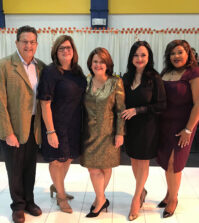




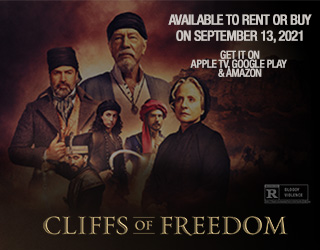

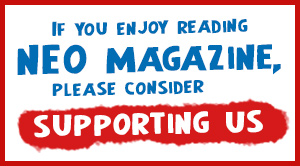



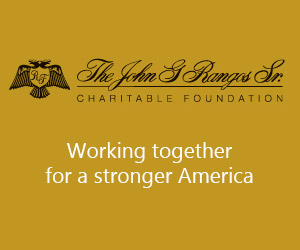


0 comments